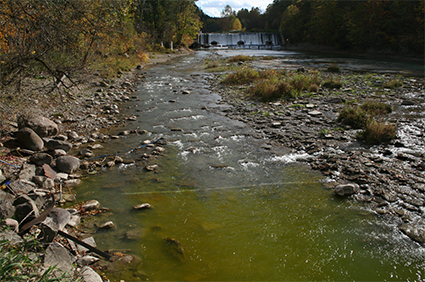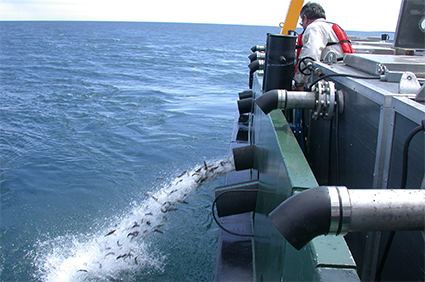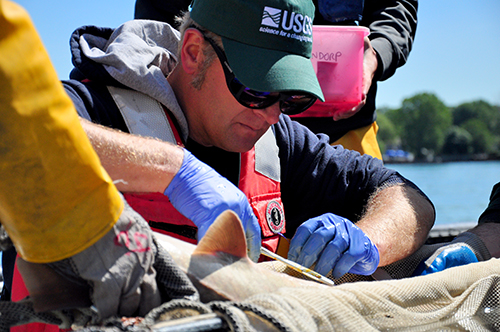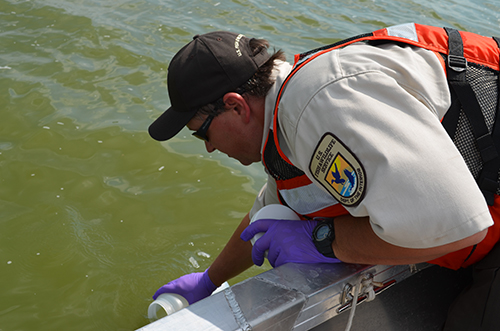Science Transfer
Purpose
The goal of the Science Transfer Program (STP) is to improve fishery management to successfully achieve fish community objectives by identifying science and science products that can inform management needs, and making science accessible to managers for decision-making.
Products
Science transfer products differ from typical research products in that they are easily accessible decision and communication support tools, such as fact sheets, slide decks, graphical figures, decision trees, or video vignettes that convey synthesized, scientifically rigorous material in simple and concise ways. Browse and download STP products from the STP Toolkit.
Process
The Science Transfer Program is advised by a Science Transfer Board (STB) consisting of fishery managers, sea lamprey control agents, and scientists. The STB identifies and prioritizes fishery management and sea lamprey control issues requiring science transfer through a "horizon scan" process. Ideas are solicited from the Council of Lake Committees, Sea Lamprey Control Board, and the broader Great Lakes management and science communities, as well as stakeholders and industry partners.
If you have a project idea or management issue that could be informed by available science, please contact the science program.
Projects
Developing consistency in interpretation and communication of non-target mortality associated with lampricide treatments
Project leader: Kaye, C.

Lampricides are highly species-specific and while rare, lampricide applications can kill aquatic species other than sea lampreys; this is called "non-target mortality." The goal of this project is to better understand non-target mortality caused by lampricides, based on science and rooted in an understanding of risks and benefits, and to clearly communicate goals, methods, and effects of the sea lamprey control program. Data from laboratory studies and stream observations will be analyzed and used to better quantify how likely and severe non-target mortality could be, set expectations for observers, and help inform management decisions (for example, during lampricide applications in areas with threatened or endangered species). Knowledge gained during the project will be used to develop clear messages for control agents to use regarding non-target mortality from lampricides.
Interactive tool for visualizing fish stocking events and recoveries in the Great Lakes
Project leader: Cottrill, A.

An interactive, online tool will be developed for Great Lakes fishery managers to visualize fish stocking events and recoveries. Fish stocking is an important method used by resource management agencies to restore and improve fish populations in support of Fish Community Objectives. More than 400 million fish have been stocked into the Great Lakes and their tributaries in the past 10 years alone. Although these stocking events are reported to the Commission and available in a database maintained by the U.S. Fish and Wildlife Service, the database is not interactive. This project uses existing tools and data to produce an interactive, web-based visualization of Great Lakes fish stocking events. Once completed, managers, agency staff, and the public will be able to visualize and interact with data on where and when fish are stocked and recovered. The interactive fish stocking tool will allow fishery managers to make more strategic decisions related to stocking programs and to communicate with their stakeholders.
From fish movement to knowledge movement: Understanding and improving science transfer related to telemetry
Project leader: Cooke, S.

Researchers use acoustic telemetry to collect information about fish movements (e.g., migration patterns, habitat use, survival). An acoustic telemetry system consists of two main components: transmitters and receivers. Transmitters are electronic tags, attached to or surgically implanted in a fish, that broadcast a series of “pings” (sound pulses) into the surrounding water. Receivers are small, data-logging computers anchored near the bottom of a lake or river that “listen” for tagged fish. When a signal is identified, the tag’s unique ID code is saved with the date and time. The Commission has invested millions of dollars since 2010 in the Great Lakes Acoustic Telemetry Observation System (GLATOS). This project seeks to understand and improve how acoustic telemetry data are used in Great Lakes fishery management decision-making. The project will identify barriers to and opportunities for telemetry knowledge use by surveying fisheries managers, clearly communicate technical aspects of telemetry including opportunities and limitations, share GLATOS success stories through management briefs, and increase relevancy of telemetry by identifying lake-specific information needs.
Uses and limitations of environmental DNA (eDNA) in fisheries management
Project leader: Welsh, A.

Environmental DNA (eDNA) is a promising technique for greatly increasing the chance of detecting relatively rare or elusive organisms, such as invasive or endangered species. The method involves taking samples from the environment (e.g., water samples) and analyzing the DNA in those samples to identify which species are present. While this technique shows potential as a cost-effective alternative to traditional surveillance methods, it also has limitations. For example, the ability of eDNA technology to quantify abundance of organisms remains a contentious issue, as does the potential ramifications of false positive and negative results. To meet the needs of Great Lakes fishery managers, we are conducting a project that will summarize potential uses and limitations of eDNA in fishery management. The products developed during this project will also transparently acknowledge areas of scientific controversy, and compile resources to help managers make informed decisions about eDNA monitoring in their jurisdictions.
Previously-funded projects
Changes in nutrient status and energy flow through lower trophic levels: Implications for Great Lakes fishery managers
Project leader: Stewart, T.
- A conceptual model was developed describing the influences of changes in water quality, food web structure, and fisheries management activities on Great Lake fish and fisheries.
- Synthesis of the literature and direct observations from Great Lakes studies confirmed a positive relationship between the total amount of total fish biomass and nutrient concentration.
- Food web structure, fish management activities and increased water clarity can aggravate or mitigate the influence of declining nutrients.
- Concepts developed during the synthesis process and from the workshop will facilitate further discussions among Great Lakes stakeholders to refine the concepts, find mutually agreeable ecosystem goals, and the means to achieve them.
- Many of the mass-balanced descriptions of Great Lakes food webs remain unpublished, others are outdated, and this needs to be corrected. Food web studies requires the integration of large amounts of multi-trophic level, multi-scale data which introduces considerable uncertainty. Methods exist for adequately accounting and understanding the consequence this uncertainty, such as linear inverse modelling (van Oevelen et al. 2010), and can be adapted to existing Great Lakes food web data (Hossain et al. 2017). Applying these methods to existing mass-balance descriptions of Great Lakes food webs would allow a more fulsome exploration of uncertainty and its consequences. Integrating isotope and biomass size spectra approaches may be another independent method to assess Great Lakes food web attributes (Jennings et al., 2002, Trebilco et al., 2013).
- Potential fish production is lower in nutrient poor systems, and as many Great Lakes ecosystems shift from mesotrophic to oligotrophic, not all fish species can be supported at historical levels, while others may thrive. However, highly functioning ecosystems and productive and diverse quality fisheries are still possible. It will be a challenge for managers to adjust their expectations and those of their clients, and to innovate and adapt their fisheries management practices.
Alternative barrier technologies: History as a control tool
Project leader: Zielinski, D.
- The Great Lakes Fishery Commission’s sea lamprey control program has generated a technologically diverse set of barrier designs that focus on influencing or exploiting a single behavioral (e.g., non-physical barriers), phenological (e.g., seasonal barriers), physiological (e.g., fixed-crest and velocity barriers), or morphological (e.g., screens and weirs) attributes to block or trap sea lamprey.
- The fixed-crest barrier has the longest history of effectively blocking sea lamprey passage; owed, in part, to its relatively straightforward design.
- The next most common designs, adjustable-crest and seasonally operated barriers utilize a similar blocking mechanism as fixed-crest barriers but have higher costs associated with staffing and risks associated with automated operation.
- Alternatives barrier technologies such as resistance weirs, velocity barriers, and vertical mount electrodes with pulsed direct current have been shown, at least experimentally, to have potential to block sea lamprey passage; however, none have been deployed yet at a management scale.
- The lesson learned from the history of sea lamprey barriers is that great caution should be exercised prior to implementing new and experimental barrier technologies at the management scale.
Accounting for potential effects on fish production from barrier removals to inform management decisions: an application of structured decision making.
Project leader: Jones, M.
- Structured Decision Making (SDM) is a useful tool to help managers, stakeholders, and researchers discuss and make effective decisions on complex fishery issues, including barrier removals in the Great Lakes.
- Modeling and field studies lend insight into the expected effects of dam removals on fish populations and communities, but many critical uncertainties remain that are important to consider in the SDM process.
STP completion reports can be accessed through the Publication Search.
Water sampling picture courtesty of ACRCC

